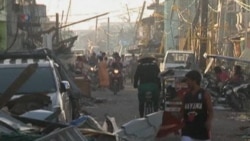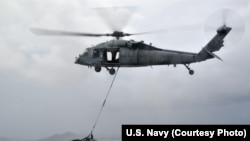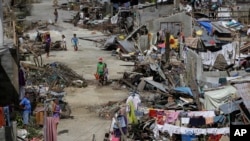The Philippine government is defending its efforts to deliver assistance to victims of Typhoon Haiyan, many of whom have received little or no assistance since the deadly storm struck a week ago.
Interior Secretary Mar Roxas says that in a situation like this, speed is of the utmost importance. Speaking Friday in the devastated city of Tacloban, he said that the need is massive, immediate and not everyone can be reached.
Disaster relief chief Eduardo del Rosario told reporters Friday that the official death toll from the storm has risen to 3,621.
Meanwhile, the U.S. Navy launched a huge relief operation Thursday.
The aircraft carrier USS George Washington and a contingent of seven supply ships began delivering water and emergency rations to Tacloban. The giant hospital ship USS Mercy is making emergency preparations to depart the United States and is expected to join the emergency flotilla within weeks, along with the British carrier HMS Illustrious.
As U.S. helicopters sped food and water to the city, reconnaissance aircraft began charting the worst-hit areas.
Brian Goldbeck, the Deputy Chief of Mission for the U.S. Embassy in Manila, said he beleives the aid distrubution is going well so far.
"I think the key point here is that a large volume of assistance was pushed through to Tacloban. Now what's happening, is that the MV-22s, the Ospreys, together with the helicopters from [the] George Washington carrier strike group, together with the Philippines' own helicopters; all of those assets are now moving resources from Tacloban to multiple points, I think 16 or 18 different drop points, yesterday and today," said Goldbeck.
The flow of relief supplies has been hampered by wrecked roadways and a lack of gasoline in and near the city. Officials say the fuel shortages have been made worse by retail merchants who are afraid to sell their gasoline supplies for fear of rioting by an increasingly desperate population.
Caught off guard
President Benigno Aquino, caught off guard by the scale of the disaster, has been criticized for the slow pace of aid distribution and unclear estimates of casualties, especially in Tacloban, capital of hardest-hit Leyte province.
The level of confusion over casualties was made plain when a notice board in Tacloban City Hall estimated the deaths at 4,000 on Friday, up from 2,000 a day before, in that town alone. Hours later, Tacloban mayor Alfred Romualdez apologized and said the toll was only an estimate, and for the whole of the central Philippines, not just Tacloban.
The toll, marked up on a whiteboard, is compiled by officials who started burying bodies in a mass grave on Thursday.
Romualdez said some people may have been swept out to sea and their bodies lost after a tsunami-like wall of seawater slammed into coastal areas. One neighborhood with a population of between 10,000 and 12,000 was now deserted, he said.
The City Hall toll was the first public acknowledgement that the number of fatalities would likely far exceed an estimate given this week by Aquino, who said the loss of life from Typhoon Haiyan would be closer to 2,000 or 2,500.
Death toll under review
Adding to the confusion, the United Nations, citing government figures, put the latest overall death toll at 4,460, but a spokeswoman said it was now reviewing the figure.
On Tuesday, Aquino said estimates of 10,000 dead by local officials were overstated and caused by “emotional trauma”. Elmer Soria, a regional police chief who made that estimate to media, was removed from his post on Thursday.
Stunned survivors in Tacloban said the toll could be many thousands. “There are a lot of dead people on the street in our neighborhood, by the trash,” said Aiza Umpacan, a 27-year-old resident of San Jose, one of the worst-hit neighborhoods.
“There are still a lot of streets that were not visited by the disaster relief operations. They are just going through the highways, not the inner streets,” he said. “The smell is getting worse and we actually have neighbors who have been brought to hospital because they are getting sick.”
The preliminary number of missing as of Friday, according to the Red Cross, rose to 25,000 from 22,000 a day earlier. That could include people who have since been located, it said.
Additional aid arrives
Meanwhile, a Norwegian merchant navy training vessel arrived at Tacloban on Friday with goods from the U.N. World Food Program, including 40 tons of rice, medical equipment and 6,200 body bags.
Boxes of aid were being unloaded at Tacloban's badly damaged airport, where more than a thousand people queued for hours hoping to evacuate. The tarmac was a hive of activity, with three large South Korean military transport planes joining two U.S. Osprey aircraft and U.S. Navy helicopters unloading and ferrying aid.
Hundreds of people, part of nearly a million who have been displaced by the storm, lined up for food and drink at an evacuee processing centre at Mactan Air Base in Cebu, the country's second-biggest city.
Some 522 evacuees passed through the centre on Thursday, with hundreds more arriving on Friday, a government coordinator, Erlinda Parame, said.
On Thursday, rescue personnel began the grim task of lowering unidentified bodies into a mass grave near Tacloban's city hall.
There were no official burial ceremonies, but a police photographer told the Associated Press that a portion of the femur was removed from each corpse. Technicians will later extract DNA from those remains to match with surviving next of kin.
United Nations humanitarian chief Valerie Amos, who toured Tacloban Wednesday, later called the situation "dismal". Despite it being monsoon season, tens of thousands of people are living in the open, exposed to wind and rain.
Interior Secretary Mar Roxas says that in a situation like this, speed is of the utmost importance. Speaking Friday in the devastated city of Tacloban, he said that the need is massive, immediate and not everyone can be reached.
Disaster relief chief Eduardo del Rosario told reporters Friday that the official death toll from the storm has risen to 3,621.
Meanwhile, the U.S. Navy launched a huge relief operation Thursday.
The aircraft carrier USS George Washington and a contingent of seven supply ships began delivering water and emergency rations to Tacloban. The giant hospital ship USS Mercy is making emergency preparations to depart the United States and is expected to join the emergency flotilla within weeks, along with the British carrier HMS Illustrious.
As U.S. helicopters sped food and water to the city, reconnaissance aircraft began charting the worst-hit areas.
Brian Goldbeck, the Deputy Chief of Mission for the U.S. Embassy in Manila, said he beleives the aid distrubution is going well so far.
"I think the key point here is that a large volume of assistance was pushed through to Tacloban. Now what's happening, is that the MV-22s, the Ospreys, together with the helicopters from [the] George Washington carrier strike group, together with the Philippines' own helicopters; all of those assets are now moving resources from Tacloban to multiple points, I think 16 or 18 different drop points, yesterday and today," said Goldbeck.
The flow of relief supplies has been hampered by wrecked roadways and a lack of gasoline in and near the city. Officials say the fuel shortages have been made worse by retail merchants who are afraid to sell their gasoline supplies for fear of rioting by an increasingly desperate population.
Caught off guard
President Benigno Aquino, caught off guard by the scale of the disaster, has been criticized for the slow pace of aid distribution and unclear estimates of casualties, especially in Tacloban, capital of hardest-hit Leyte province.
The level of confusion over casualties was made plain when a notice board in Tacloban City Hall estimated the deaths at 4,000 on Friday, up from 2,000 a day before, in that town alone. Hours later, Tacloban mayor Alfred Romualdez apologized and said the toll was only an estimate, and for the whole of the central Philippines, not just Tacloban.
The toll, marked up on a whiteboard, is compiled by officials who started burying bodies in a mass grave on Thursday.
Romualdez said some people may have been swept out to sea and their bodies lost after a tsunami-like wall of seawater slammed into coastal areas. One neighborhood with a population of between 10,000 and 12,000 was now deserted, he said.
The City Hall toll was the first public acknowledgement that the number of fatalities would likely far exceed an estimate given this week by Aquino, who said the loss of life from Typhoon Haiyan would be closer to 2,000 or 2,500.
Death toll under review
Adding to the confusion, the United Nations, citing government figures, put the latest overall death toll at 4,460, but a spokeswoman said it was now reviewing the figure.
On Tuesday, Aquino said estimates of 10,000 dead by local officials were overstated and caused by “emotional trauma”. Elmer Soria, a regional police chief who made that estimate to media, was removed from his post on Thursday.
Stunned survivors in Tacloban said the toll could be many thousands. “There are a lot of dead people on the street in our neighborhood, by the trash,” said Aiza Umpacan, a 27-year-old resident of San Jose, one of the worst-hit neighborhoods.
“There are still a lot of streets that were not visited by the disaster relief operations. They are just going through the highways, not the inner streets,” he said. “The smell is getting worse and we actually have neighbors who have been brought to hospital because they are getting sick.”
The preliminary number of missing as of Friday, according to the Red Cross, rose to 25,000 from 22,000 a day earlier. That could include people who have since been located, it said.
Additional aid arrives
Meanwhile, a Norwegian merchant navy training vessel arrived at Tacloban on Friday with goods from the U.N. World Food Program, including 40 tons of rice, medical equipment and 6,200 body bags.
Boxes of aid were being unloaded at Tacloban's badly damaged airport, where more than a thousand people queued for hours hoping to evacuate. The tarmac was a hive of activity, with three large South Korean military transport planes joining two U.S. Osprey aircraft and U.S. Navy helicopters unloading and ferrying aid.
Hundreds of people, part of nearly a million who have been displaced by the storm, lined up for food and drink at an evacuee processing centre at Mactan Air Base in Cebu, the country's second-biggest city.
Some 522 evacuees passed through the centre on Thursday, with hundreds more arriving on Friday, a government coordinator, Erlinda Parame, said.
On Thursday, rescue personnel began the grim task of lowering unidentified bodies into a mass grave near Tacloban's city hall.
There were no official burial ceremonies, but a police photographer told the Associated Press that a portion of the femur was removed from each corpse. Technicians will later extract DNA from those remains to match with surviving next of kin.
United Nations humanitarian chief Valerie Amos, who toured Tacloban Wednesday, later called the situation "dismal". Despite it being monsoon season, tens of thousands of people are living in the open, exposed to wind and rain.














